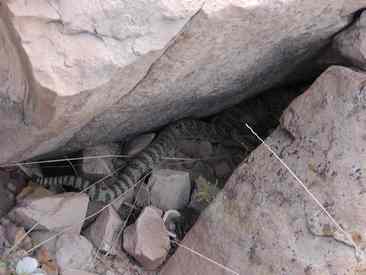 |   For more critters, visit the main gallery through the link at the bottom of this page A freind and I were out looking for trilobites in Thistle Utah when we came across a bed of rattlesnakes. So this one was a risky shot to get. Considering the fact that we were in the middle of the rattlesnake den before they started rattling, I'd have to say there was some luck involved with us not getting bit, but once they rattled I knew they were there and we were relatively safe from then on. My friend panicked and ran to the top of a large rock and stayed there, yelling at me to be careful while I grabbed my camera out of the bag and ran after one that was about five feet long. I chased it between some rocks, and expected it to be gone before I could get more than this shot.
Rather than continue to run away like he could have, he coiled up and prepared to strike. I jumped down from the rocks he went under and took a safe position about a foot out of striking distance. Really, as scary as it is that's all you need, a foot too far for a snake is far enough and you won't get bit. So I took it to the limit. Unfortunately, I don't have a clear picture of him rattling because every time he rattled I was too nervous to hold the camera steady. I wonder why.
This particular rattlesnake is called a Great Basin Rattlesnake Crotalus viridis lotusus and was extremely difficult to identify precicely, due to a large number of similar species. It is a well proportioned snake that can be found in the Great Basin region of the Western United States. This one appeared to be about five feet long.
I cropped the rattle out of the original image so you can get a better look at it. A rattlesnake's rattle can sometimes give you an idea of how long the snake has been around. This one has shed it's skin 10 times, which you can tell because the rattle is still completely intact with no lost segments. So it is not the largest rattle you will see but it is definitely a nice specimen and a hospital visit. As a rattlesnake grows, it needs to shed it's skin because it gets too large for it. It sheds it all at one time, and leaves the empty skin behind. Every time a rattlesnake sheds it's skin it gets another link added to the rattle. So the older the snake, the better it can rattle. This one had enough to warn you from a distance, it is as nice as any you would be likely to see. If I had been bit, it probably would not have been fatal, after all in rattlesnake country there is always anti-venom nearby. However, if left untreated you will probably die. If you can get to a hospital within an hour or two you will almost definitely make it. Six hours, you might not. If you wait longer than that, your chances of recovery are not good. However, a rattlesnake does not always inject venom. Sometimes they will do a dry bite. Rattlesnake venom contains proteins that the rattlesnake would rather keep, so sometimes they do not inject anything. If you get bit, you will know if venom got injected because swelling begins to take place quickly. You should stay as calm as possible, move as little as possible and get to a hospital as soon as possible. When I took this shot we were 200 feet from the car and a 40 minute drive to the hospital, so I was a lot less careful than I would have been if we had backpacked 10 miles in to the San Rafael Swell, which was one of my favorite hangouts. If you get bit back in there you are on your own. You can carry a venom extractor, but I never wasted my time with that; I think they are foolish gimmicks. But there is a new way to treat rattlesnake bites that was developed by a missionary doctor named Dr. Guerdian in Ecuador, South America. In his area there are numerous snake bites, and little anti-venom, - whatever antivenom there is comes at an enormous cost. So he decided to try using electricity to neutralize the venom. He pulled the coil wire off of a boat motor and used the ignition system as a high voltage power source. He discovered that when he applied the voltage to the snake bites the venom was neutralized. Now there is a modified stun gun called "The Snake Doctor" that is used to treat bites at rattlesnake roundups in the United States. Though it is not approved by the FDA, it does indeed work so if I could make it back to the truck while out on the San Rafael, guess what I would do . . . . . :-) For more critters visit the Main Gallery References * Rattlesnake, Portriate of a Predator, Manny Rubio; Smithsonian 1998 * Venomous Reptiles of North America, Carl H. Ernst; Smithsonian 1992 * Venomous Snakes of the World, Mark O'Shea; Princeton University Press 2005 * My own experience and knowledge * Photography by Jim Stone, These are unique images, all rights reserved. |  |

 Click the link for a larger and clearer picture of this
Click the link for a larger and clearer picture of this 